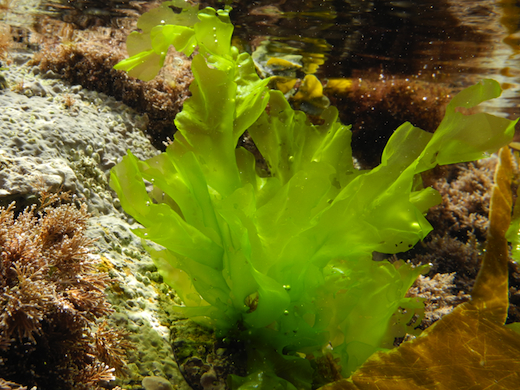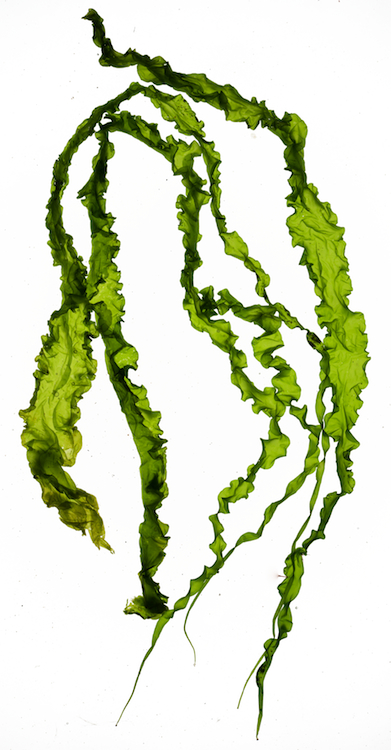Ulva: Sea lettuce
 This is a small genus of marine and brackish water green algae. It is edible and is often called 'Sea Lettuce'. Species with hollow, one-layered thalli were formerly included in Enteromorpha, but it is widely accepted now that such species should be included in Ulva.
This is a small genus of marine and brackish water green algae. It is edible and is often called 'Sea Lettuce'. Species with hollow, one-layered thalli were formerly included in Enteromorpha, but it is widely accepted now that such species should be included in Ulva.
The thallus of ulvoid species is flat and blade-like and is composed of two layers of cells. There is no differentiation into tissues; all the cells of the plant are more or less alike except for the basal cells, which are elongated to form attachment rhizoids. Each cell contains one nucleus and has a cup-shaped choroplast with a single pyrenoid.
 Ulva undergoes a very definite alternation of generations. Biflagellate isogametes are formed by certain cells of the haploid, gametangial plant. These are liberated and fuse in pairs to form a diploid zygote which germinates to form a separate diploid plant called the sporophyte; this resembles the haploid gametangial plant in outward appearance. Certain cells of the sporophyte undergo meiosis and form zoospores in sporangia; these zoospores are quite different to the gametes in that they form quadriflagellate zoospores (with 4 flagella). These are released, swim around for a time, settle and germinate to form the haploid gametangial thallus. Note that the haploid gametes are capable of settling and germinating without fusion to form a haploid thallus directly; most Ulva populations reproduce by this form of parthenogenesis and sexual reproduction appears not to be very common.
Ulva undergoes a very definite alternation of generations. Biflagellate isogametes are formed by certain cells of the haploid, gametangial plant. These are liberated and fuse in pairs to form a diploid zygote which germinates to form a separate diploid plant called the sporophyte; this resembles the haploid gametangial plant in outward appearance. Certain cells of the sporophyte undergo meiosis and form zoospores in sporangia; these zoospores are quite different to the gametes in that they form quadriflagellate zoospores (with 4 flagella). These are released, swim around for a time, settle and germinate to form the haploid gametangial thallus. Note that the haploid gametes are capable of settling and germinating without fusion to form a haploid thallus directly; most Ulva populations reproduce by this form of parthenogenesis and sexual reproduction appears not to be very common.
Ulva can be quite a nuisance in areas that are nutrient enriched from sewage outfalls e.g. Cork Harbour and Belfast Lough, where populations of Ulva may cover large areas of mudflats in the summer.
There are about 100 species Ulva currently listed on AlgaeBase which is probably a considerable underestimate; nearly 600 names have been used, as this was one of the earliest genera of algae to be described (by Carl Linnaeus). There is a full description of the genus on the site.
Pictures above of Ulva lactuca (top) and Ulva linza © M.D. Guiry





